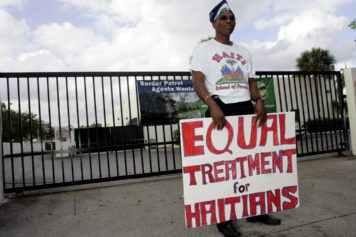
Time is running out for thousands of Haitian and Somali immigrants who are at risk of being deported from the U.S. (Photo by Guillermo Arias/ AFP/ Getty Images)
Blacked Out: Immigrants of African Descent Overlooked in Trump’s War on Foreign-Born Residents
With the scope of public opinion focused squarely on the ongoing immigration debate, it’s becoming harder and harder to erase the images of children separated and placed in detainment facilities, with some unlikely to be reunited with their parents, if at all. But as the Supreme Court’s recent decision to uphold the Muslim ban confirms, elections have consequences, and in this case the lives of Americans and immigrants alike will continue to be impacted by them.
For those drawn to Trump’s ability to tell it like it is, he’s doing exactly what they expected him to do, following months of rhetoric that included calling Hispanics “rapists,” describing Haiti and African countries as “shitholes” and telling Fox News that Muslims are “a group of people that’s very sick.”
America’s immigration system has changed, and the cost of the ongoing political war is mounting for non-natives currently living in the country. And while the Hispanic community sits in the crosshairs of the Trump administration’s push for an immigration overhaul, others have been affected as well.
That includes Black immigrants, which Pew Research estimated had reached a population of 3.8 million by 2013, four times the amount documented in 1980. Black immigration has climbed steadily since the 1960s, thanks in part to the Immigration and Nationality Act of 1965 that also created a new category for political refugees seeking asylum in the United States.
Prior to that, the flow of immigration was based on the country of origin, the result of the Emergency Quota Act of 1921 that essentially gave preference to European nations. This legislative loophole allowed up to 51,227 Germans to enter the U.S. after its passage, while African countries were limited to just 1,100, a biased quota system that President John F. Kennedy once described as “intolerable.”
The 1965 act would help shift America’s demographics, as more immigrants from African and Caribbean nations started migrating to the United States.
Center for American Progress breaks the demographic down as “The largest individual home countries of black immigrants in the United States today are Jamaica (693,000), Haiti (654,000), Nigeria (304,000), Ethiopia (237,000), and Trinidad and Tobago (171,000).”
But with the Muslim ban now the official law of the land, those fleeing persecution or militant attacks in countries like Somalia are now unable to enter the country legally. As the New York Times recently remarked, “There is no escape to America.” While previous generations of immigrants were welcomed by the Statue of Liberty’s declaration of “Give me your tired, your poor, your huddled masses yearning to breathe free,” others have found a less welcoming version of America.
Sharing his own experience with the Times, Mohamud Noor, a Somali-American activist, reacted to the recent SCOTUS ruling by explaining “I think we were expecting the Supreme Court would stand on moral grounds.”
“We live in America. This is a land of immigrants,” said Noor.
Black emigrants from Somalia and Libya — the only African nations among the list of seven countries on the recent Supreme Court–approved travel ban list — now find the door to U.S. entry barred to them, but many foreign-born Blacks already in the United States face the threat of deportation because of a separate immigration directive by the Trump administration.
Temporary Protected Status designations currently give shelter in the United States to more than 400,000 immigrants fleeing strife and natural disasters in their native countries. TPS beneficiaries hail from nations ranging from South Sudan to El Salvador, and some 58,000 Haitians face deportation within a year in the wake of the Trump administration’s refusal to renew protections to nationals from a country that is still reeling from the effects of the 2010 Haiti earthquake.
In some regards Black immigrants have fared slightly better than native-born Black Americans, including scholastically, where African-born immigrants boast a higher education level than the general U.S. population thanks in part to an emphasis on STEM courses. To date, nearly 40% hold a bachelor’s degree. When it comes to race, however, they are nowhere near exempt from the harsh realities of being Black in America; including a President that has previously suggested that Nigerians would not “go back to their huts” if allowed entry into the county, and also claimed that Haitians “all have AIDS.” Welcome to America, indeed.
Those already here are now facing an increase in ICE deportations, including those being sent back Senegal, Gambia and Guinea.
“Other countries whose nationals experienced a significant spike in removals are Senegal, with the number of people removed jumping more than nine times to 197 from 21 the previous year, while Gambian removals increased to 56 from 2 the previous year, Guinea’s rose to 88 from 1,” Quartz found.
They also discovered that although “Overall removals dropped to 226,119 in 2017 from 240,255 in 2016, the number rose for Africans — in many cases, more than doubling from the previous year.”
While Black immigrants are statistically more likely to have entered the country legally, an analysis from the Harvard Political Review cautions that “As Black immigrants steadily increase their numbers in the United States, they will have to face the reality of more run-ins with law enforcement due to racial profiling. This has dire consequences, particularly for Black immigrants who are undocumented.”
Black Americans are more likely to face discrimination in areas including housing, the environment and even the way in which they’re perceived by law enforcement. When it comes to immigration, non-native blacks face similar challenges, with Black immigrants more likely to be roped into the system and unceremoniously removed from the country.
Recent administrations also ramped up deportation efforts, but most threw their efforts into focusing on those with felony convictions. Instead the current White House has deemed all immigrants (at least the black and brown ones) as threats.
“For the Nigerian American community, it is simply disheartening that such hard-working immigrants with numerous academic achievements would be so derisively dismissed by the U.S. president,” admonished Emmanuel Ogebe, who sought political asylum in 1997.
Writing for the Los Angeles Times, he added, “Hundreds of Nigerian medical doctors are helping sustain the U.S. medical system, which is in dire need of foreign medical professionals as longer-living baby boomers strain the system.”
Reflecting on America’s immigration history, law professor César García Hernández explained, “Donald Trump’s rhetoric vacillates between deplorable and blatantly racist, but it is an extension of the rhetoric of migrant criminality that has dominated political conversations about immigration for decades.”
“Republicans and Democrats have frequently grouped migrants into two camps: the good ones and the bad ones,” Hernández added, presumably including the “rapists and murderers” boogeymen that Trump has infamously referred to.
With no clear fix for America’s ongoing immigration crisis, research from the Black Alliance for Just Immigration finds that “Black immigrants are much more likely than nationals from other regions to be deported due to a criminal conviction.”
Cautioning against pitting “brown against black,” Alliance organizer Zack Mohamed has worked to humanize the immigration debate.
BAJI “was created to basically have the dialogue and the narrative around that black migrants do exist,” Mohamed told Los Angeles Times. “And that is true in L.A. as is all the nation.”


